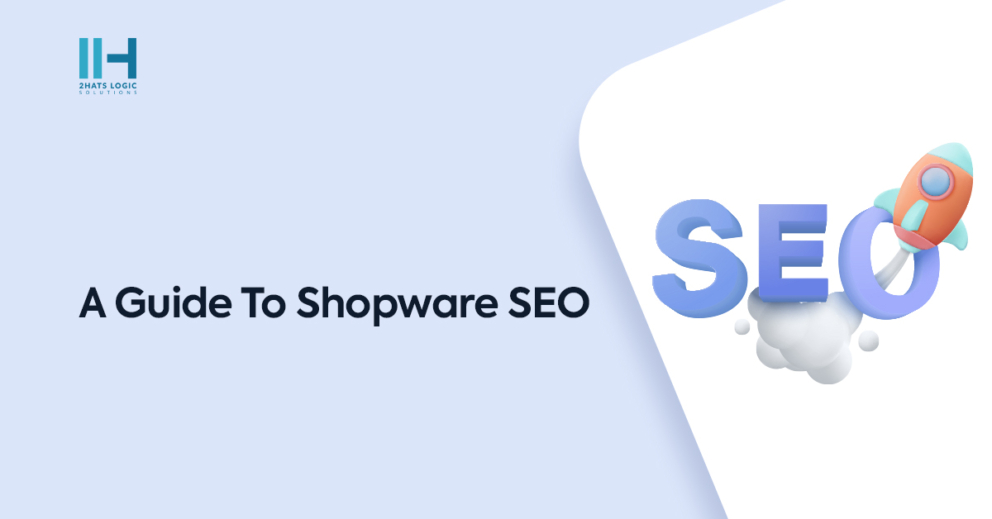Greetings! I'm Aneesh Sreedharan, CEO of 2Hats Logic Solutions. At 2Hats Logic Solutions, we are dedicated to providing technical expertise and resolving your concerns in the world of technology. Our blog page serves as a resource where we share insights and experiences, offering valuable perspectives on your queries.
Whether you’re an e-commerce pro or just setting out in online retailing, having a good handle on Shopware SEO can make or break your business. From keyword research and on-page optimization to technical SEO and content strategies, every component of this guide is designed to provide you with the tools and expertise you need to increase the visibility of your Shopware shop and promote long-term success. This comprehensive guide will give you the necessary knowledge and tactics to optimize your Shopware website for search engines and improve visibility, drive organic traffic, and increase sales.
What is Shopware?
Shopware is an innovative e-commerce platform that allows business proprietors to create unique and engaging online shopping experiences. Shopware’s customizability of design and rich feature set allows the merchant to build and nurture their online businesses according to their individual needs. Our Shopware agency caters to all requirements for selling products and services online, starting from easy integration with a wide range of payment methods, complete marketing tools, and more. Shopware offers flexibility and scalability for small and large businesses.
Need help with Shopware SEO? Our experts optimize your online store to achieve effective results.
Why is SEO so important for Shopware?
Shopware SEO has a lot of benefits, it gives higher returns on your investment in marketing. SEO gives better long-term value from improved search results. In other words, SEOs are of great importance if you need to grow traffic, improve user experience, improve conversions, build trust, be productive, and maximize ROI on your Shopware site.
- Driving Organic Traffic: Shopware SEO enables the business to rank better on results pages of search engines, generating more consumers without experiencing the expenses related to paid advertising.
- Improving User Experience: Shopware SEO helps site pace, mobile hospitality, and accessibility. A better user experience keeps visitors engaged for longer, decreases bounce rates, and leads to greater ratings from consumers
- Increasing Conversion Rates: By targeting customers who are actively searching for your items, Shopware SEO increases the possibility of conversions, resulting in higher-quality leads and more purchases from visitors who are ready to buy.
- Remaining Competitive: With so many competitors investing in SEO, it is critical to keep your market presence. Effective Shopware SEO techniques ensure that your store is visible and competitive.
Methods to improve Shopware SEO
Keywords
Keywords directive plays a very crucial role in enhancing the general operation of Shopware SEO. Keywords present in a given web page serve as the foundation for all other SEO operations; thus identifying the most optimal keywords is the first and one of the most vital steps. Here are the steps that you can take to build your first website:
- Keyword Research
It is recommended that you use Google Keywords Planner, Ahrefs, Semrush, etc, to get relevant keywords concerning the prominence of your products. Target longer keywords as they are relatively easy to rank while yielding good conversion rates.
- Keyword Strategy
You must select keywords or phrases that are associated with specific types of products that you sell in your store. Organic-looking keywords can be incorporated into your product description, category pages and any other page of your Shopware site.
- Competitor Analysis
You need to know the keyword that your opponents are targeting by examining the websites of your competitors. Both Ahrefs and SEMrush can help to find out terms and topics that a competitor is using and what might be effective.
- Content Optimization
Advise that your content is optimized for the selected keywords. This is accounted for by the appropriate application of the keywords in meta title tags, meta description tags, headings and within the content of the site.
- Regular Updates
Keep your keyword strategy dynamic by regularly updating it based on the latest trends and changes in search engine algorithms. Monitor the performance of your keywords and adjust your strategy accordingly.
- User Intent
Create content for which the purpose is not just to hit keywords and have those keywords in the content, but also to address the purpose that the user with the aforementioned keywords has.
Shopware SEO Optimizer for URLs, 301 Redirects, & Canonicals – What Is It?
SEO-Friendly URLs:
- Make your URLs efficient and readable and incorporate target keyword phrases.
- No special characters, numbers or unrelated words in the tagline and should not include special characters, numerals or any unnecessary words.
Example: Instead of shopware. com/cat123?prod=567, use shopware.com/women-shoes-sneakers.
301 Redirects:
- This means using the 301 redirects to move the content to a new URL permanently.
- This assists in the preservation of the SEO value corresponding to the primary URL and prevents users from getting to a 404 page.
Example: To redirect the old-page-URL to new-page-URL.
Canonical Tags:
- Use the canonical links to point out which copy is the original one in case many exist.
- This is important for cases when there is a necessity to deal with such problems as duplicate content and pagination.
Example: <link rel=”canonical” href=”https://shopware. com/preferred-url” />.
On-Page Shopware SEO
Create Convincing Product Descriptions
- Omit by far the most extensive and convincing product descriptions.
- It is also important to use and emphasize the keywords and explain to the customers the advantages of your products.
Category Texts for More Visibility
- The Heading Structure: Headings (H1, H2, H3, etc.), use headings to divide the text into sections with the help of a consistent scheme.
- The primary keyword must also be used in the H1 tag of the site and it should summarize the outline of the page.
- Optimize simple category descriptions for keywords to be found in the title and the text.
This makes it easier for the search engines to crawl the options and enable identification of the relevance of the categories.
Images SEO for Shopware
- The file names of the images should be descriptive and so should the alt texts.
- Optimize images because at times large images slow down website loading while maintaining quality.
Navigation
- User-Friendly Navigation, make sure that the site is easily navigable and has a logical menu.
- Search for ways to improve the users’ experience and the internal linking by using breadcrumbs.
Technical Shopware SEO
- Schemas for More Attention in the SERPs – Schema markups directly boost a website’s position on the Search Engine Results Page. However, Google has clarified that schema rank-up is not a ranking factor, but it would improve the website’s content to be more comprehensible and accessible to search engines.
- Sitemaps & Robots. txt – For indexing your shop create and submit an XML sitemap to search engines to help them crawl your site efficiently. Use
robots.txtto control which parts of your site should be indexed. - Loading Times & Mobile Optimization – Page Speed, the user should consider optimizing images, enabling the usage of browser caching and, in some instances, utilising a CDN.
- It must be underlined that mobile optimization is important because Google uses mobile-first indexation.
Free SEO Extensions and Tools for Website Audit
Do you feel like improving the search engine performance of your website? Then these free SEO extensions and tools will let you have easy website audits done.
- SEO Meta in 1 Click
SEO Meta in 1 Click is a simple, yet powerful browser extension that will help in the review and optimization of meta tags on web pages. One-click browser extension: installed, it integrates with your browser for instant access to critical metatag information with a single click.
Here’s how it works: each time you visit a website, you can tap on the SEO Meta 1 Click plugin by clicking on the icon in the browser toolbar. A small pop-up box opens to show significant meta tag information about the page title, meta description, and meta keywords. This gives a quick overview of how well the page is optimized for search engines.
- Hreflang Checker
Hreflang Checker is a tool for checking Hreflang tags on a website. These are very important tags for international and foreign websites, as they describe to the search engines the language and geography of targeting.
An Hreflang Checker inspects the website code to check whether Hreflang tags have been appropriately used across several language versions or regional variations of the site. Once initiated, the Hreflang Checker processes the page in search of Hreflang elements in the HTML source code. It then confirms that the results are correct and consistent, indicating that they point to the relevant language or regional versions of the material.
- Screaming Frog
Screaming Frog is an impressive SEO software that can assist in carrying out a professional website checklist. It is a website crawler that offers you an opportunity to review the fundamental details of your website and check on-page SEO problems.
After installing Screaming Frog and launching it, one can enter the website URL to experience the crawling. Screaming Frog will then crawl the whole of your website, evaluating feasible objects, tags, definition words, links, and content duplication, among others. It creates a detailed report on these aspects and assists in rectifying SEO problems.
- SEOquake
SEOquake is a universal plugin that enables its users to investigate and analyze SEO factors and problems in websites. It acts as a browser plug-in that displays real-time data as well as analysis.
To use SEOquake you must run the plug-in which will be present in the toolbar of your browser. The first time you run an analysis on a page, you will be shown a floating window with basic SEO parameters: the PageRank position, Alexa rank, the number of pages Google has indexed and the parameters of the site’s accounts in social networks. It also includes a comprehensive report about the specified webpage that has some basic and advanced characteristics of the selected webpage such as meta tags, headings, internal and external links, and other ones.
Shopware 5 Vs Shopware 6 SEO
| Aspect | Shopware 5 SEO | Shopware 6 SEO |
| Technical SEO | Offers partial support in technical SEO features. | Enhanced technical SEO features. |
| Content SEO | Basic features for the optimization of content. | Advanced optimization tools for content optimization and several options. |
| URL Structure | Fixed URL structure with minimal options for customization. | Flexible URL structure with improved options for customization. |
| Meta Tags | Limited customization options on the meta tags. | Expansion to customize meta tags. |
| Schema Markup | Supports schema markup but with some limitations. | Supports schema markup with increased improvements. |
| Performance | Limitations in performance. | Improved performance and efficiency. |
| Compatibility | It works with present SEO plugins and tools. | It integrates even better with SEO plugins and tools. |
| User Experience | Basic UX features that can be improved further. | Enhanced UX features and optimizations. |
| Tracking & Analytics | Limited tracking and analytics capabilities. | Expanded tracking and analytics capabilities. |
| Mobile Optimization | Provides basic features in mobile optimization. | Optimized with enhanced features in mobile optimization. |
In short, Shopware 6 SEO is very technically improved and has enhanced content optimization tools, a flexible URL structure, expanded meta tag customization options, better schema markup, better performance, and efficiency. It also features better compatibility with SEO plugins and tools, enhanced user experience features, and expanded tracking and analytics features compared to Shopware 5. It is recommended to migrate from Shopware 5 to 6 to improve the overall performance.
Tracking in Shopware: Google Analytics 4, Google Shopping & Google Tag Manager
Tracking in Shopware is essential for merchants who wish to understand more about their customers, improve their marketing efforts, and enhance the overall efficiency of their online business. Utilizing tracking tools and analysing significant metrics, merchants can make data-driven decisions that result in their success and growth.
Essence of tracking
The essence of tracking is to gain insight into some of the most crucial components of your e-commerce business. Here are some major pointers:
- Customer Behaviour: The tracking function of Shopware 6 enables you to track how customers check out your online store, and which items they view, add to basket, and purchase. This information assists you in figuring out their taste and action patterns.
- Optimize Marketing Efforts: Metrics to be monitored include source of traffic, conversion rates, and campaign efficiency; all these metrics enable one to refine the marketing strategy to reach the audience and platforms effectively.
- Improve User Experience: Tracking shows areas where user behaviour can be improved, such as reducing the loading time of pages, streamlining the checkout methods, and enhancing site navigation.
- Product Performance: You can log in to track to evaluate how popular and efficient your products are by observing metrics such as views, add-to-cart rates, and sales; this enables you to improve what you sell.
- Measuring ROI: This is a source where tracking helps in the monitoring of investment impact for your marketing operations, allowing you to be sensible in resource allocation and income generation.
- Operational Efficiency: These metrics will show you the effectiveness of your inventory, order fulfilment, and customer service metrics; tracking in Shopware 6 ensures the process is smooth and effective.
Google Analytics 4 with Shopware 6
Connecting Google Analytics 4 with Shopware 6 allows linking the strong tracking engine from Google to your online e-commerce platform, which would easily allow you to monitor the key parameters of success with an online store.
- Website Traffic: It will help you measure the number of customers who visit your website, where they come from, and what pages they view.
- User Engagement: You can measure user engagement with the site in product page views, adding items to the cart, or completing purchases.
- Other general metrics include Conversion Rate—This will help you track how well your website is converting visitors into clients and will give you great insight into how successful your marketing and sales efforts are.
It helps with all this information, which will give you valuable insights to help you make your marketing easier to manage, improve user experience on the website, and expand an online business.
Shopware: Google shopping and SEO
Google Shopping and SEO are crucial elements in making your Shopware store visible to the maximum and most effective audience. Google Shopping enables sellers to show product ads right on Google search, targeting shoppers who are actively looking for products similar to your own. Customize your product listing, title, description, and photos to improve performance on Google Shopping and increase quality traffic to your online store.
Similarly, Shopware SEO can help enhance your online store’s organic search engine ranks. You can make your products easily discoverable by search engines like Google by making sure that on-page elements like product titles, meta descriptions, and URL structures are optimized. Moreover, the SEO-friendly features of Shopware, such as canonical tags and sitemap generation, enhance your store’s visibility and accessibility to search engine crawlers.
Merchants can establish a strong online presence, get targeted traffic, and drive sales and business growth by implementing effective Google Shopping campaigns and robust SEO practices in Shopware.
Google Tag Manager
Google Tag Manager is a better way to manage tracking codes on your e-commerce site because it offers a user-friendly interface to remove the use of coding by hand. This means that instead of making manual changes to the code of your website, you can add tracking programs through Google Tag Manager.
Due to complex capabilities like triggers and variables, this relation makes it easier for retailers to effectively adjust their tracking setups. Triggers allow you to define the conditions under which tracking tags should be triggered, whereas variables let you dynamically populate tag setups with relevant data.
In a nutshell, Google Tag Manager in Shopware 6 makes tracking management easier and makes your monitoring data more reliable, giving you deep insights into user behaviour, which may help boost business growth by making you a more responsible decision-maker for your e-commerce strategy.
SEO Tips & Tricks for Shopware
- This means that there should always be production of new content, which replaces the old one.
- Check your SEO indicators with the help of Google Analytics and Google Search Console.
- Backlinks help enhance domain authority, therefore one should ensure that they create quality backlinks.
Conclusion
ShopwareSEO is more than just a technique; it is one of the critical elements of success strategy for Shopware e-commerce companies. With Shopware, you have a robust platform that offers a solid foundation for creating and optimizing online stores for search engines. Having read this Shopware SEO guide, we recommend adopting many of the recommended steps. Also for more technical and guided handling you can hire Shopware developer who can help you with their expertise. With Shopware developers they help you to increase the visibility and traffic rate for Shopware stores as well as their sales.
FAQ
Why is Shopware SEO good?
Shopware is an advanced e-commerce solution aimed at providing customised shopping experiences on the Internet. Shopware SEO is an added advantage since it is provided with customised design, strong features, and SEO tools which assist in enhancing visibility, traffic and sales.
What tools can help with Shopware SEO audits?
SEO tools which can be used to conduct Shopware SEO audits include SEO Meta in 1 Click, Hreflang Checker, Screaming Frog, and SEOquake. These tools also help to analyse meta tags, Hreflang tags, and other SEO problems connected with page and, in general, website performance.
How does Shopware 6 improve SEO compared to Shopware 5?
Shopware 6 provides better SEO-based technical features such as strong content optimization controls, flexible URL structure, expanded meta tags customization, better performances and strong compatibility with SEO plugins and tools as compared to Shopware 5.
How can I optimize images for Shopware SEO?
Shopware image optimization tips include providing the image file with an accurate name and title, having the appropriate alt text, using image compression tools, and using images that will not slow down the browsing of mobile devices.
What is the importance of backlinks in Shopware SEO?
Backlinks are very important when it comes to increasing domain authority and ranking on search engines. Quality backlinks from relevant and trustworthy sources provide more traffic for your Shopware store, as more people will consider the content as relevant and credible.







